Installation of cassette air conditioners: technological rules for installing a household cassette unit
Cassette air conditioning is a high-performance technique with a modern design and low noise characteristics. This is an ideal option for air conditioning, but installation of cassette air conditioners is only possible if the room has a suspended ceiling and appropriate dimensions.
In this article we will talk about the operational capabilities of cassette-type air conditioners. Let's get acquainted with the rules for installing this equipment.
The content of the article:
Design features of the cassette player
Although a cassette air conditioner is a type of split system, it differs from other types in the specific design of the internal module. It is predominantly square in shape and designed to be built into a suspended ceiling structure.
All of its parameters are tailored to the task of installing a cassette-type air conditioner in the ceiling:
- the outer panel measures about 50x50 cm;
- the depth, from 20 to 35 cm, coincides with the corresponding parameters of the suspended ceiling - the standard cell size and the distance from the surface of the canvas to the ceiling.
The air conditioner can operate in both cooling and heat the room if necessary.
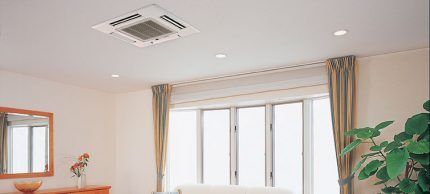
The outdoor module is equipped with a compressor and a condenser.The interior has an evaporator and a drainage system.
Advantages of a cassette air conditioner
Structurally, the “cassette box” is designed in such a way that cooled air is blown out in 4 directions. While the wall-mounted counterpart cools relatively small rooms, cassette air conditioner can cover a fairly large area.
In addition to a large coverage area, this practical technique has a number of other advantages:
- Aesthetics. The indoor units remain invisible because they are located behind the suspended ceiling. Hidden installation does not change the interior of the room, which allows the use of such climate control equipment in representative premises and offices.
- Almost complete absence of noise during operation. The fan built into the unit creates natural circulation of air masses, does not create turbulence, and effectively pumps air.
- Maximum room coverage. Since warm air accumulates in the area where the air conditioner is located, the room temperature will decrease gradually from top to bottom.
- Convenient air flow control. Using the rotating bars, you can direct the air jets at your discretion.
Cassette air conditioning systems for large premises are controlled not only by portable remote controls, but also by installing stationary panels connected to the building's electrical network.

Many cassette systems have additional features. They can heat the room, ionize and humidify the air.To be able to fully coordinate the operation of air conditioners, you can install a unified climate control system.
Installation of cassette air conditioner
Installation in new buildings and in other types of premises is identical. Although there are some nuances, in general the technology is similar.
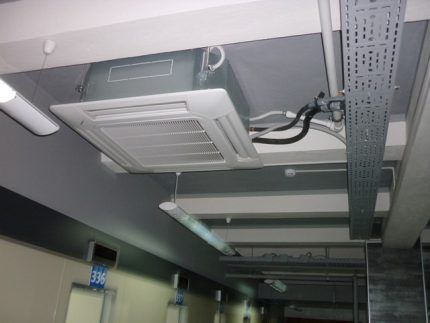
The whole process can be divided into several stages:
- installation of blocks - external and internal;
- laying air ducts and power lines;
- installation of a control panel if the air conditioner is installed at a large facility;
- testing, adjustment.
The installation of the air conditioner must be carried out taking into account the climatic conditions of the region. If the air contains aggressive substances, they can negatively affect the operation of the device, so an additional air filter will be required.
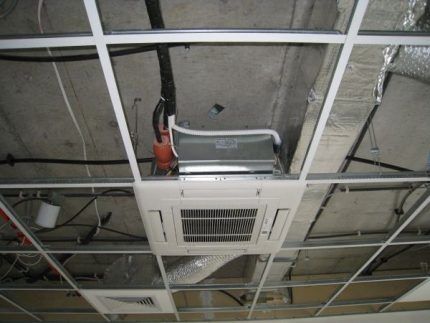
A guarantee of successful operation of the air conditioner is compliance with all rules installation of the external unit and internal module:
- The wiring must be thick enough to withstand high loads.
- It is not recommended to install any air conditioners in industrial premises where the air contains vapors of acids and other toxic and flammable substances in high concentrations.
- Cassette air conditioners must not be installed in places where they may come into contact with technical oils.
- The height of the room should not be less than 2.6 m.
- The ceiling must be strong and as horizontal as possible.
- The unit must be completely grounded, both the circuit and the metal base.
- There should be no obstacles left in the air conditioner installation area after the work is completed.
- The gaps between the air conditioner body and the extreme points of the holes must be equal.
The order in which the air conditioner units are installed does not matter, but until it is at the installation site, it is not recommended to unpack it. The cassette player works most effectively when the indoor module is installed in the center of the ceiling.
Installation of the indoor unit
In most cases, the air conditioner comes with a cardboard sample of identical dimensions. But even if it is missing, you need to do it yourself. It will be useful as a template for marking.

Before you begin attaching the internal cassette units of air conditioners to the ceiling, you must first draw an outline on the floor and then transfer it to the ceiling. Next, a small cut is made in the ceiling profile. If the suspended structure vibrates, a piece of foam plastic is glued to the ceiling.
Next, mark the mounting locations for the module, drill holes in the marked locations to a depth of about 50 mm with a diameter of 12 mm and insert pins into them. A nut, a washer and another nut are screwed onto each stud. After this, the internal module is lifted up, the studs are inserted into the grooves intended for them, and the nuts are tightened.
The block for internal installation is installed so that it fits flush with the surface of the ceiling panel. This will happen if the distance between the main and suspended ceilings is identical to the immersion depth of the “cassette player” body.
The horizontality of the plane is controlled by a level. If you skip this procedure, the drainage fluid inside the module will leak out and drip onto your head. When the condition of flatness of the plane is met, tighten the nuts well. The distance between the modules of the unit is measured in order to subsequently lay the freon line.
At the next stage, the highway is cut. This operation requires great precision, down to the millimeter. An error with the size will complicate things. Insufficient length means additional financial investment. Larger quantities can be hidden in the intershelf space.

A disc pipe cutter is most suitable for cutting the main line. You cannot cut with a hacksaw or grinder. These tools can leave metal shavings, which can subsequently negatively affect the performance of the air conditioner.
The cut is carefully cleaned with a file or sandpaper, and the shavings are shaken out. The hole formed as a result of cutting the pipe is closed with tape or tape, and the pipe itself is insulated.
Studs with hooks are attached to the ceiling to secure the freon pipeline. If you need to change the geometry of the pipe, use a pipe bender, but before doing this, cut the insulation and move it back a little. Having completed the procedure, the ceiling surface is sealed back.
If it is necessary to expand the pipeline, a special flaring machine is used, which increases the internal cross-section of the pipe to match its external one. Adjust the size gradually - making about three passes, each time increasing the size of the collet. Otherwise, the pipe may burst.
The hoses are brought to the holes of the internal module, the fixing nuts are unscrewed and put on the tubes. The ends are cleaned with a file, and shavings are collected with a vacuum cleaner. Using a flaring tool, expand the diameter of the pipe so that it covers the nozzle of the indoor unit. The tube is clamped and secured with a nut using keys. One of them holds the nozzle, and the second tightens the nut.
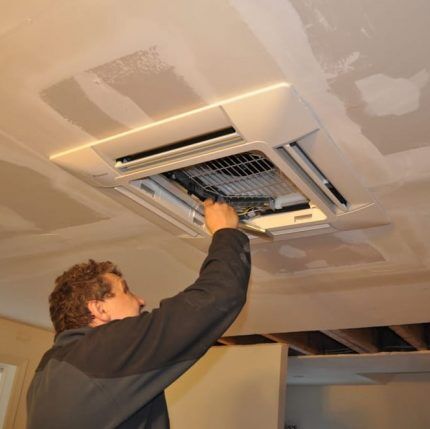
The junction area is insulated and tightened with clamps. Next, remove the air intake grille and put it aside for a while. Then take out the 4 corner plugs and find the motor with which the blinds move. This position must necessarily be combined with the connection point of the freon line.
Fix the overlay in the area of the brackets on the block, carefully move the latter so that it fits exactly into the hole. Using a level, level the cladding and return the air intake grille to its place, securing it on the sides with plugs.
The use of units is limited by the installation height of the cassette air conditioner, because they cannot be installed in an apartment with a ceiling height of 2.5 m. Based on this requirement, it is recommended to use cassette players in rooms with a height of at least 3 m.
Installation of a street block
Installation of a street block is possible subject to certain points:
- rigidity of the surface intended for installation;
- no obstacles in the way of air flow;
- the presence of metal plates to protect the unit from strong gusty winds;
- the closest possible distance between blocks;
- taking into account the difference between the geometric center of the block and its center of mass.
When moving the block, it must not be tilted more than 45⁰. It is strictly forbidden to place the module on its side.

In the case when the option of “floor” fixation of the external block is chosen, it needs its own concrete foundation, otherwise the structure will not be able to resist gusts of wind. Fastening is carried out using a bracket for the air conditioner.
After this, a pipeline is installed into the room to remove the refrigerant from the condenser. The main thing is to ensure a minimum of cold losses on the section of the main line from the external to the internal unit.
The installation location should be chosen so that there is no snow or leaves on the module. When the air conditioner operates for heating, the condensate discharged from the outdoor unit should not cause any inconvenience.
Nuances of installing a pipeline and drainage system
To increase the service life of the air conditioner, it is necessary to take into account several nuances:
- The length of the line intended for refrigerant circulation must not be exceeded.
- More than 15 bends in the pipeline should not be allowed. Bends of more than 90⁰ and a radius of more than 9-10 cm are unacceptable.
- After installing the sockets, mandatory vacuum cleaning of the circuit from excess air, dust, and moisture is required.To do this, a valve is connected to the pump along the external circuit. During the procedure, all tubes should be visually checked for integrity.
- To fully ensure the integrity of the system, the joints can be covered with a soap solution after filling the tubes with freon.
If necessary, the system is topped up with refrigerant. Refilling is required when the pipeline in one direction is longer than 8 m.
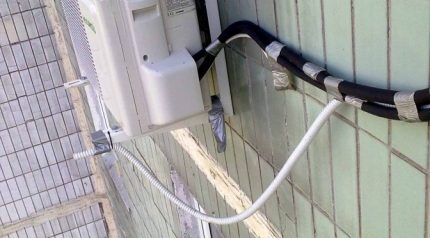
Work on installing a drainage system begins with connecting a plastic pipe to the drainage pump of the indoor unit. It is put on the pipe and secured with a clamp. Next, the pipe is pulled to the drainage point. Typically, the outer diameter of the pipe is 37-39 mm, the inner diameter is 32 mm.
The laying is done at a slight angle - literally a few centimeters for every square meter. In general, the slope is a maximum of 30⁰, ─ the rise is no more than 20 cm. The waste should leave the air conditioner by gravity and under no circumstances be returned to the collection tank.
The other end of the drainage pipe should not be immersed in liquid. To check the functionality of the drainage system, pour water into a special hole and turn on the air conditioner in cooling mode. In this situation, the pump and drain will show their work.
Connecting the air conditioner to the mains
A special feature of the cassette air conditioner connection diagram is that it can only be connected to an individual machine. If there is no voltage stabilizer in the general wiring, it is advisable to add this element to the circuit.
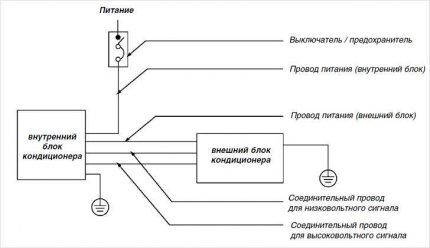
Both indoor and outdoor units must be grounded. Subsequently, the grounding will be combined into a single circuit. If an extension cord is needed, it requires a cable of the same type and cross-section.
Please note that the wires must not intersect with refrigeration pipelines or shut-off valves. There must be fuses in the power circuit.
After installation is complete, you need to press the control panel and start the unit in test mode. You should listen to how the engines in the blocks work. If there are extraneous sounds, rattling or vibration, the unit must be turned off and the cause of the problem must be looked for.
Conclusions and useful video on the topic
Experience installing the internal cassette player unit in these two videos:
Second part of the guide:
How to connect pipelines and power supply to a cassette air conditioner, you will learn from this video material:
Installation of cassette air conditioners is usually carried out by service technicians. This is explained both by the complexity of fastening and organizing air communications, and by the need for adjustment work. The latter require some experience, since the design of the equipment contains many components, incl. electronics and automation.
Tell us about how you installed a cassette air conditioner in your office or country house. It is possible that your recommendations will be very useful to site visitors.Please write comments in the form below, ask questions and post photos on the topic of the article.



